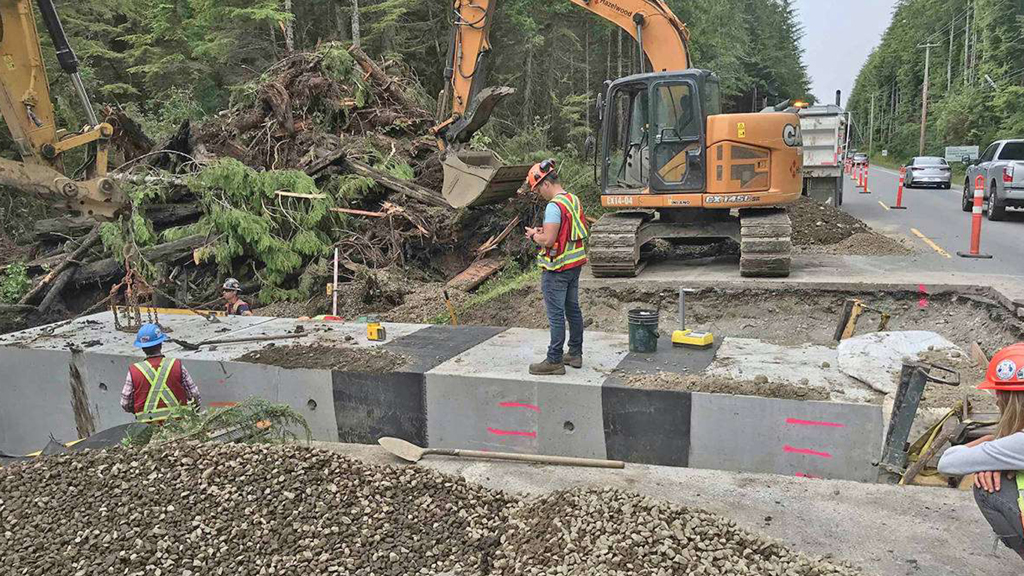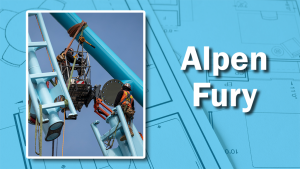Construction crews were called in recently to install an underground highway of sorts at Pacific Rim National Park Reserve on Vancouver Island, B.C., so that northern red-legged frogs could hop to safety.
The unusual project involved building three separate 17-metre-long tunnels under Highway 4 between Tofino and Ucluelet so that the little amphibians could cross under the two-lane road to their breeding grounds.
The frogs, which are listed on a federal Species of Special Concern list, are partial to wetland and forest habitats and must cross the road to get to Swan Lake, roughly half a kilometre away. The four-hectare wetland is a breeding habitat for the frogs and other amphibians. Hundreds of the tiny creatures die each year making the journey across the thoroughfare.
Construction crews spent two days in the area installing and joining up 2.5-metre-long culverts that will enable the frogs and others to leap to safety under the highway.
“They used a pretty big excavator to dig the trench and also lift the pieces of culvert into place,” says Dr. Barb Beasley, founding director of the Association of Wetland Stewards for Clayoquot and Barkley Sounds. “I was quite impressed with the attitude of the workers that did the work and their gung-ho-ness.”
The sections were connected end-to-end to create crossing structures with a height of 30 centimetres – ample clearance for the frogs to hop through the tunnels to the other side. Soil and logs were placed inside the tunnels to provide natural cover and encourage the amphibians to make the journey under the road.
Open-grate manholes were installed near the centre of the crossings to allow some natural light into the tunnels. Outside the crossings, permanent directional fencing and a lock block wall were constructed parallel to the highway to funnel the creatures into the crossings and away from the roadway.
To install the culverts, crews used a rock hammer to punch through the roadway and remove the top layer of asphalt. An excavator was used to dig the trench and a layer of crushed gravel was added to the bottom. A hydraulic hoe-packer was used to compact the material before the culverts were laid in place.
“The hard work was stuffing the culverts with the soil and getting the soil even throughout the section,” says Beasley. “The operator would dump material at the entrance to each section and push it in with a log.”
It was painstaking work. The culverts had to be carefully positioned. After each culvert was lowered into place, a worker had to slide sideways into the opening and use a shovel to grade the material inside. A mix of sand and pebble material was mixed with organic material and spread inside the culvert so it would remain moist and drain properly. The three tunnels are roughly 50 metres apart.
“It kind of mimics the kind of habit that they’re in in the forest,” explains Beasley. “To make that better, we then put lots of branches and needles inside the culvert and the foliage from the forest as well as some logs so that it feels more like the forest floor. They also have cover for protection from predators.”
Highway 4 is the main corridor on the west coast of Vancouver Island and a key artery for the two Pacific Coast communities, as well as the main road through the park reserve. The decision to build the tunnels was largely guided by data collected by Beasley. She’s been collecting information on the frog migration since 2004.
“The three highway crossings have now been fully installed beneath the highway in time for the fall when amphibian migration events are more common,” says Parks Canada spokesperson Nancy Hildebrand.
“This is an example of Parks Canada’s recognized leadership in conservation and in taking action to preserve national parks and national marine conservation areas and contribute to the recovery of species at risk.”
Over time as the road mortality of the frogs declines, it’s expected to have a positive impact on the population in the area, she adds. An added benefit is that other wildlife may also use the passages.
It took a team of half a dozen workers two days to complete the work. Prior to the actual installation, however, there were many hours of planning, preparation and environmental worked involved in the project.
More work remains to be done. Installing the amphibian fencing, for example, has proven to be detailed and specialized work. Some of that work will occur this fall and the remainder during the spring months.
Monitoring of the passages and adjacent fencing will continue over the winter to determine if any fine-tuning is needed to ensure the structures are functioning as planned.
“We haven’t actually put cameras in them which is how we will monitor them,” notes Beasley. “We haven’t got that part lined up yet, but I hope to do that over the next year or so. I feel pretty confident they will get used because we have monitored a previous tunnel we installed in 2011 and we see a lot of animals moving through them. I feel pretty sure that the frogs are going to find them and use them.”











Recent Comments
comments for this post are closed